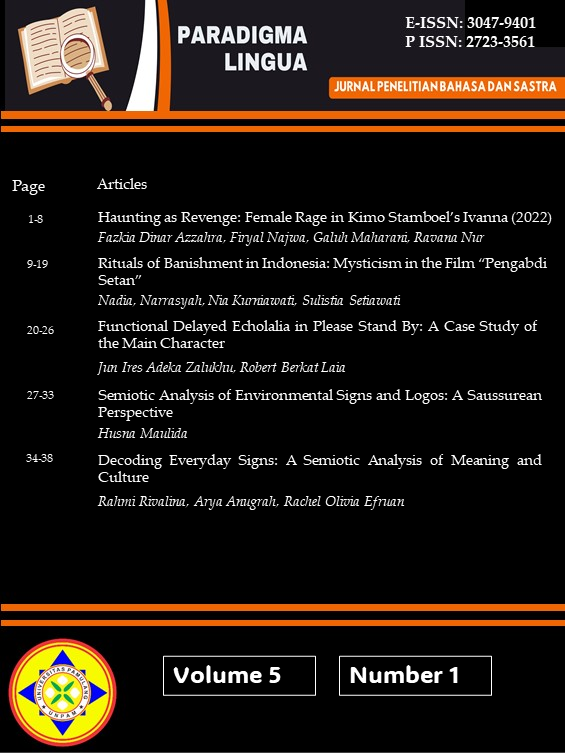Haunting as Revenge: Female Rage in Kimo Stamboel’s Ivanna (2022)
Keywords:
betrayal, folklore, horror, monstrous-feminine, revengeAbstract
Indonesia’s rich cultural heritage and folklore are deeply intertwined with ghost stories, which have significantly influenced the country’s horror film genre. Ivanna (2022), directed by Kimo Stamboel, explores the vengeance of a Dutch colonial woman’s ghost, reflecting themes of betrayal and historical injustice. This study examines how Ivanna represents the “monstrous-feminine,” drawing on Barbara Creed’s theory to analyze the depiction of female rage and societal taboos. Through qualitative analysis of the film’s narrative elements, this research highlights how Indonesian horror films often portray female ghosts as symbols of resistance against patriarchal injustices. The findings contribute to a deeper understanding of gender representation and cultural narratives in Indonesian horror cinema.
References
Cornett, B. (2024, n.d.). The supernatural horror genre explained: Books, movies & more. Cornett Fiction. https://www.cornettfiction.com/supernatural-horror-genre-explained/
Gill, R. (2006). Mastering English literature. Bloomsbury Publishing.
Heryanto, A. (2008). Pop culture and competing identities. In S. H. Donald (Ed.), Popular culture in Indonesia; Fluid identities in post-authorian politics (pp. 1-9). Routlegde media.
Kenney, W. P. (1966). How to analyze fiction. Monarch Press. https://archive.org/details/howtoanalyzefict00wil_udn
Larasati, A. W., & J. Adiprasetio. (2022). Ketimpangan representasi hantu perempuan pada film horror Indonesia periode 1970-2019. ProTVF, 6(1), 21-42. https://doi.org/10.24198/ptvf.v6i1.36296
Malewitz, R. (2021, February 8). What is a setting? Definition & examples. Oregon State University. https://liberalarts.oregonstate.edu/wlf/what-setting
McGregor, L. (2022, February 4). Understanding point of view in film and video. Premium Beat. https://www.premiumbeat.com/blog/understanding-pov-in-film-and-video/
Pangastuti, A. (2019). Female sexploitation in Indonesian horror film: Sundel Bolong (A Perforated Prostitute Ghost, 1981), Gairah Malam III (Night Passion III, 1996) and Air Terjun Pengantin (Lost Paradise-Playmates in Hell, 2009) (Doctoral dissertation, Auckland University of Technology, Auckland, New Zealand). Tuwhera Open Access.
Permatasari, S. D. R., & Widisanti, N. M. (2019). Hantu perempuan sebagai “produk gagal” dalam dua film horor indonesia: pengabdi setan (2017) dan asih (2018). Media bahasa, sastra, dan budaya wahana, 25(1), 86-97. https://doi.org/10.33751/wahana.v25i1.1220
Punjabi, M. [@manojpunjabimd]. (2022, August 30). Terima kasih untuk 2.793.775 penonton yang sudah merasakan teror dendam IVANNA di bioskop. Terima kasih atas dukungan dan antusiasme kalian, kini saatnya kami pamit. Tetap dukung perfilman Indonesia! #JeritanTerorIVANNA #DendamIVANNA #IVANNA #DanurUniverse #MDPictures #MDEntertainment #pichouseFILMS [Instagram video]. Instagram. https://www.instagram.com/reel/Ch4jMsMOL0B/
Storey, J. (2006). Cultural theory and popular culture; An introduction. (5th ed.). Pearson Education.
The Economist. (2024, September 5). Why Indonesia’s horror films are booming. The Economist. https://www.economist.com/asia/2024/09/05/why-indonesias-horror-films-are-booming
Wakefield, S. (2023, February, 20). A closer look at the horror genre. The Book Coach. https://www.thebookcoach.co/post/a-closer-look-at-the-horror-genre
Octavita, R. A., & Zaimar, Y. S. (2018). Semiotic in interpreting the text of women's role Indonesian horror film in "Setan Jamu Gendong". Journal of English Language and Culture, 9(1) https://doi.org/10.30813/jelc.v9i1.1452
Ndoen, S. (2022). The ‘monstrous-feminine’ as anti-communist propaganda tool: Invisible state violence and psychological warfare in Soeharto era folkloric horror films. The Twelfth International Convention of Asia Scholars (ICAS 12), 500-507. https://doi.org/10.5117/9789048557820/icas.2022.058
Downloads
Published
Issue
Section
License
Authors who publish with this journal agree to the following terms:
- Authors retain copyright and grant the journal right of first publication with the work simultaneously licensed under a Creative Commons Attribution License that allows others to share the work with an acknowledgement of the work's authorship and initial publication in this journal.
- Authors are able to enter into separate, additional contractual arrangements for the non-exclusive distribution of the journal's published version of the work (e.g., post it to an institutional repository or publish it in a book), with an acknowledgement of its initial publication in this journal.
- Authors are permitted and encouraged to post their work online (e.g., in institutional repositories or on their website) prior to and during the submission process, as it can lead to productive exchanges, as well as earlier and greater citation of published work (See The Effect of Open Access).
Paradigma Lingua have CC-BY-SA or an equivalent license as the optimal license for the publication, distribution, use, and reuse of scholarly work.
In developing strategy and setting priorities, Paradigma Lingua recognize that free access is better than priced access, libre access is better than free access, and libre under CC-BY-SA or the equivalent is better than libre under more restrictive open licenses. We should achieve what we can when we can. We should not delay achieving free in order to achieve libre, and we should not stop with free when we can achieve libre.


